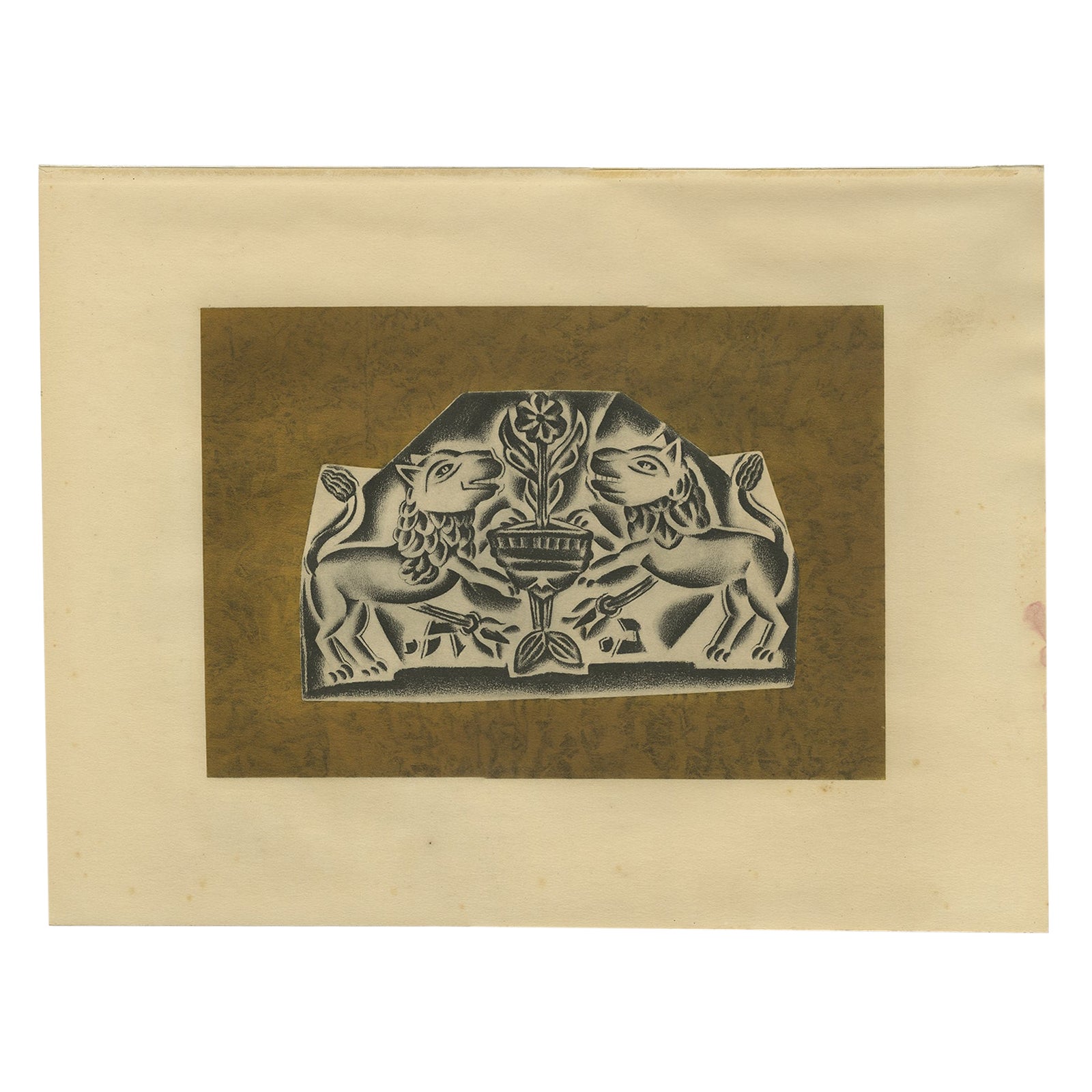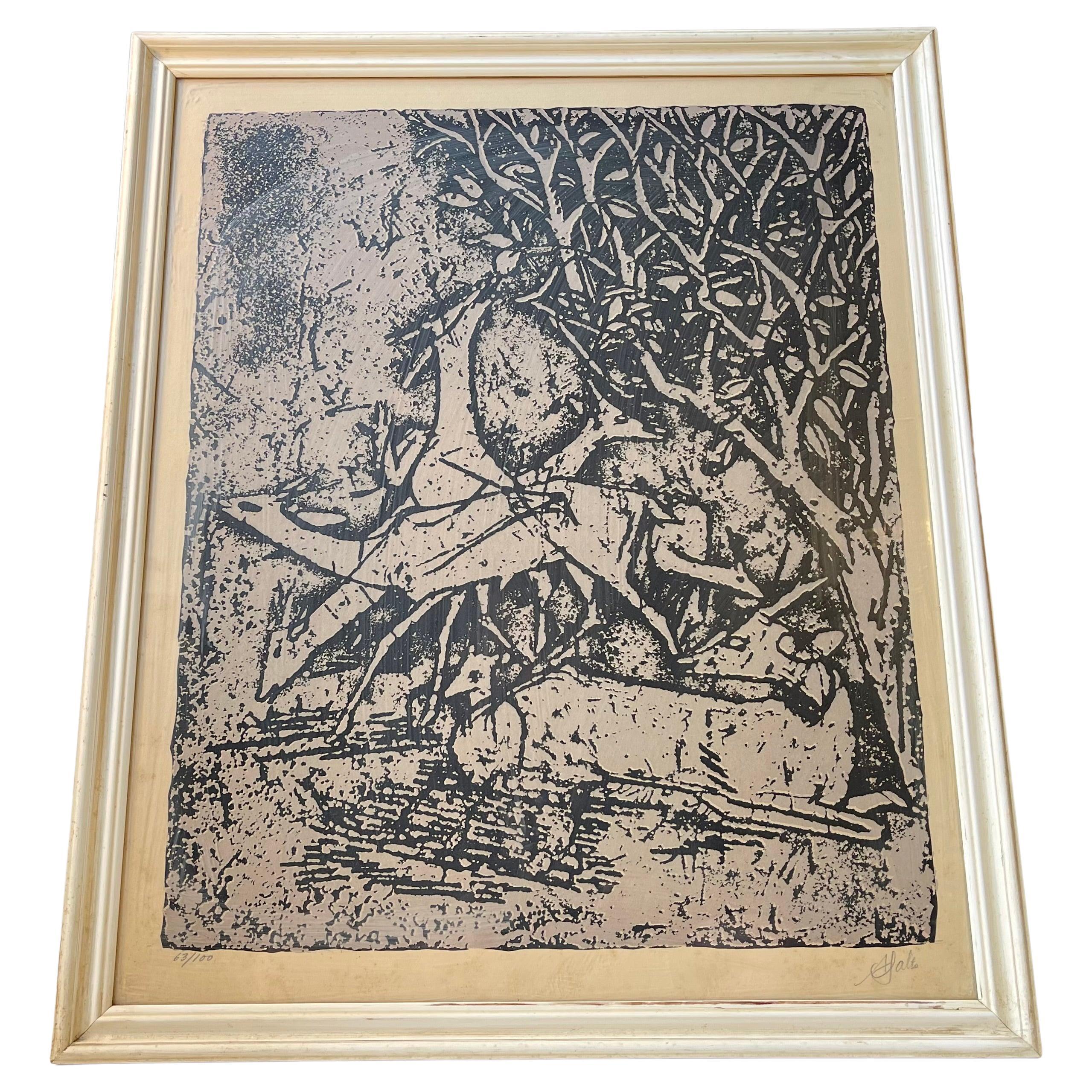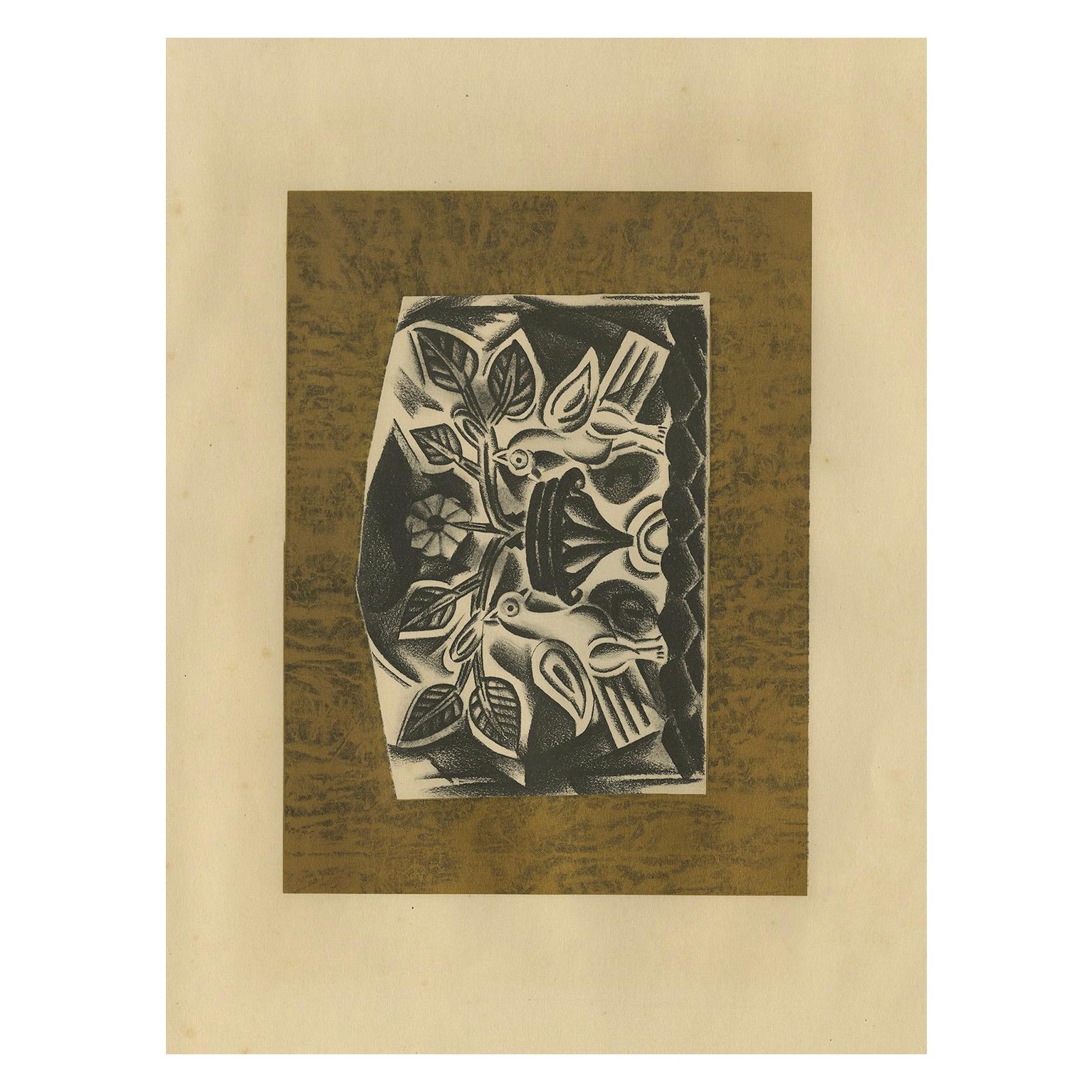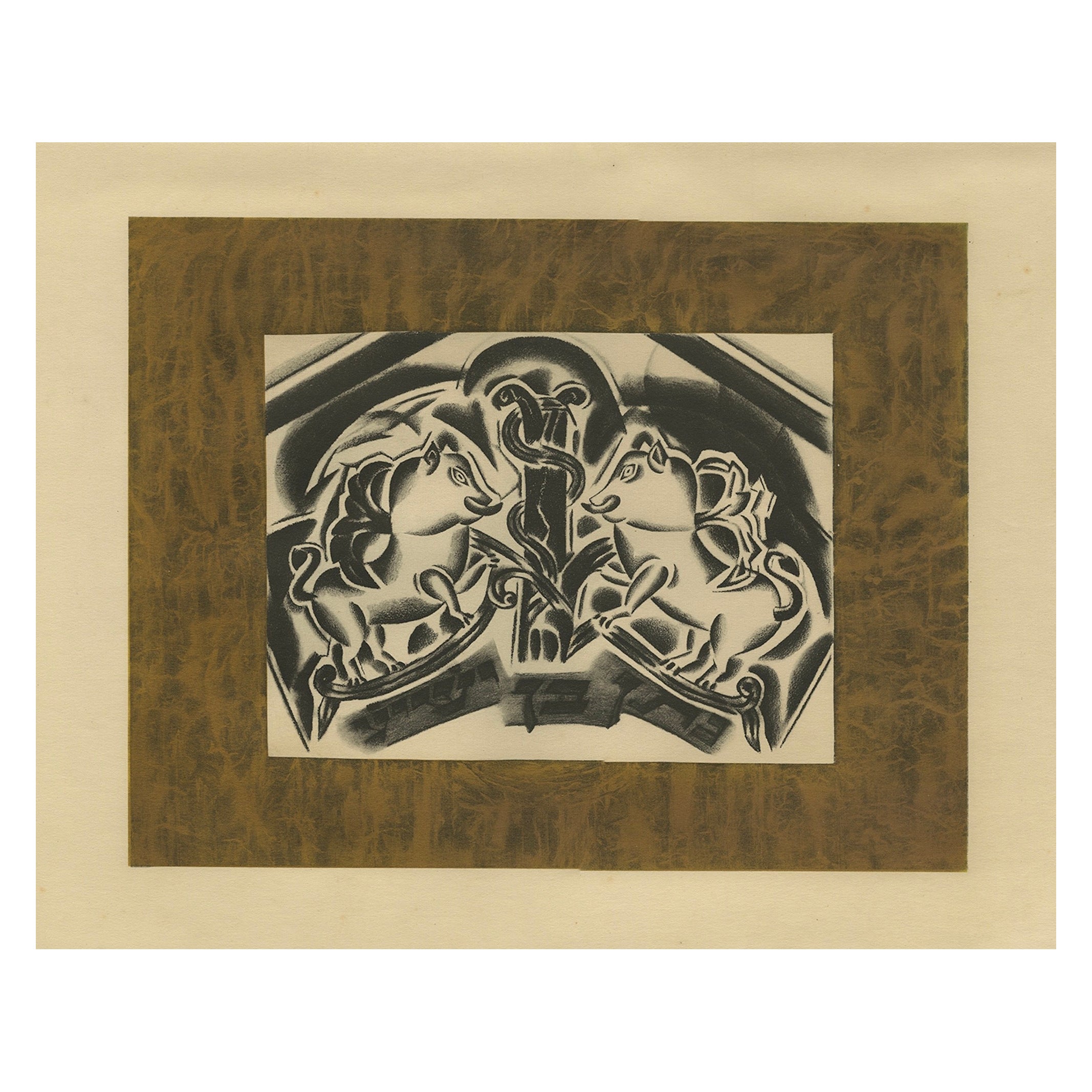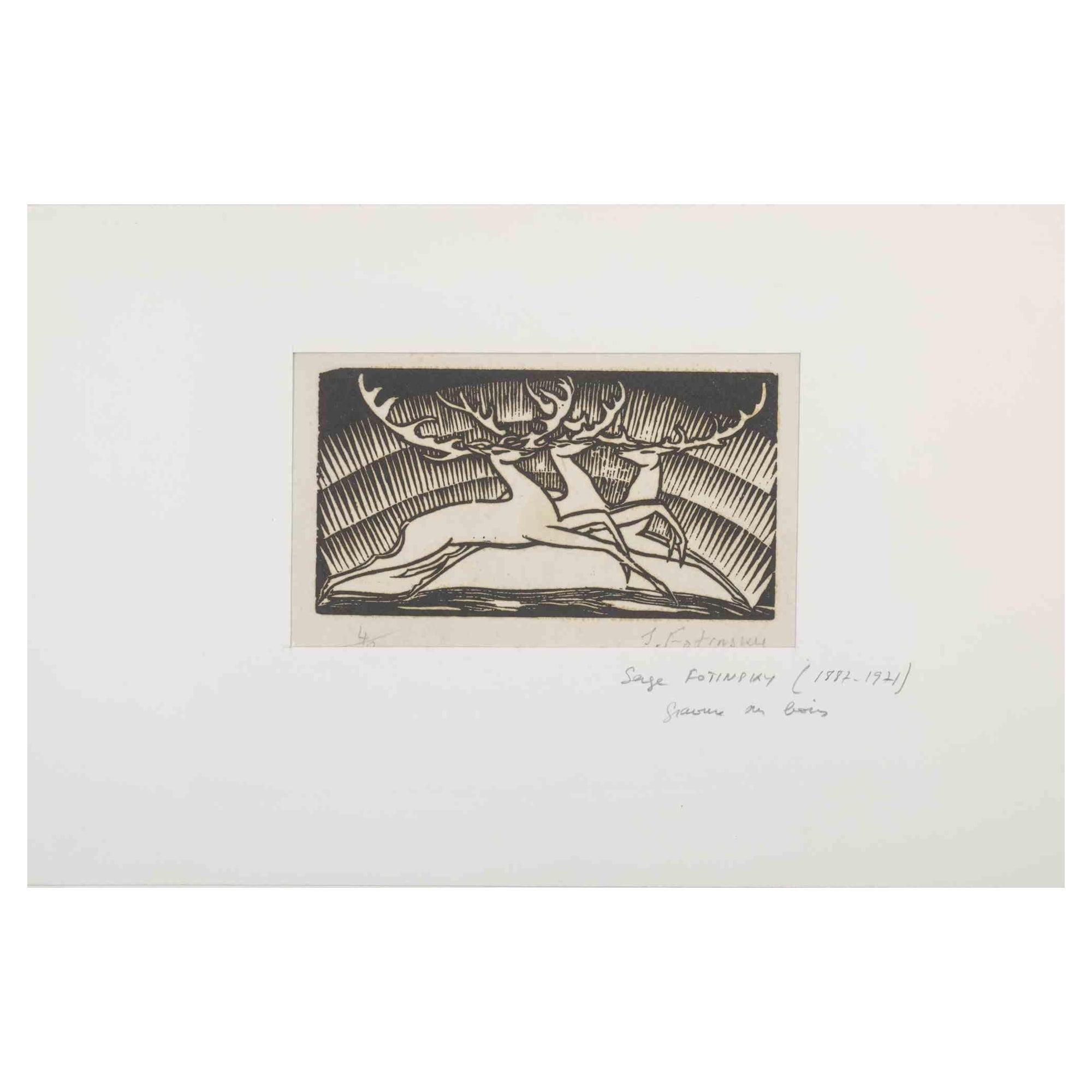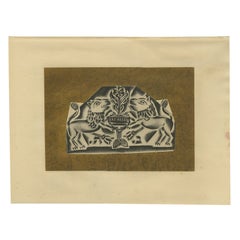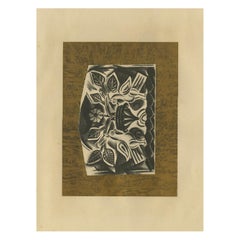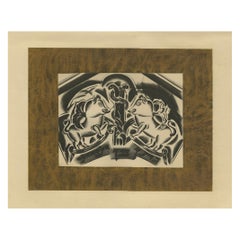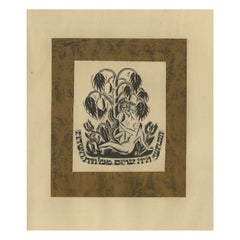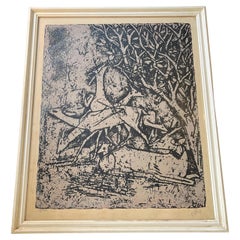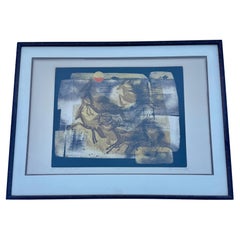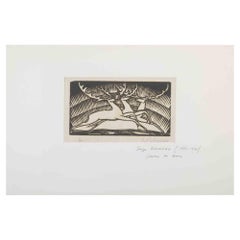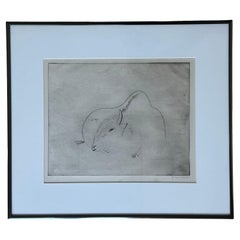Items Similar to Der Ruhende Hirsch, 1923: Rare Deer Lithograph by Nathan Altmann
Want more images or videos?
Request additional images or videos from the seller
1 of 6
Der Ruhende Hirsch, 1923: Rare Deer Lithograph by Nathan Altmann
$1,028.25
$1,468.9230% Off
£760.36
£1,086.2230% Off
€861
€1,23030% Off
CA$1,412.40
CA$2,017.7130% Off
A$1,570.51
A$2,243.5830% Off
CHF 822.19
CHF 1,174.5530% Off
MX$19,184.01
MX$27,405.7330% Off
NOK 10,331.60
NOK 14,759.4330% Off
SEK 9,718.94
SEK 13,884.2030% Off
DKK 6,555.85
DKK 9,365.5030% Off
About the Item
"Der Ruhende Hirsch" (The Resting Deer) is an evocative lithograph by Nathan Altman, featured in the "Jüdische Graphik" series from 1923. This print presents a serene depiction of a resting deer, rendered in stark black and white, contrasted beautifully against a burnished gold background which emphasizes the graceful form and calm posture of the deer.
This artwork exemplifies Altman's mastery in blending Cubist influences with more figurative elements, creating a composition that is both modern in its abstraction and classical in its subject. The geometrical and fragmented shapes surrounding the deer enhance the peaceful yet dynamic nature of the scene, inviting the viewer to reflect on the tranquility and vulnerability of the animal.
As part of the limited edition series published in Berlin by "Petropolis," only 250 copies of this particular print were created, adding to its rarity and collectible value. Altman's work, deeply rooted in his Jewish heritage and avant-garde aesthetics, offers a unique perspective on traditional subjects, making "Der Ruhende Hirsch" a significant piece for collectors and admirers of early 20th-century art. The print not only captures a moment of rest but also symbolizes the peaceful coexistence of nature and artistic innovation.
- Dimensions:Height: 13.98 in (35.5 cm)Width: 18.9 in (48 cm)Depth: 0 in (0.02 mm)
- Materials and Techniques:
- Period:
- Date of Manufacture:1923
- Condition:Good, given age. Light scattered foxing in the margins and visible on verso, image clean. General age-related toning and/or occasional minor defects from handling. Please study scan carefully.
- Seller Location:Langweer, NL
- Reference Number:Seller: PCT-588801stDibs: LU3054341411612
About the Seller
5.0
Recognized Seller
These prestigious sellers are industry leaders and represent the highest echelon for item quality and design.
Platinum Seller
Premium sellers with a 4.7+ rating and 24-hour response times
Established in 2009
1stDibs seller since 2017
2,604 sales on 1stDibs
Typical response time: <1 hour
- ShippingRetrieving quote...Shipping from: Langweer, Netherlands
- Return Policy
Authenticity Guarantee
In the unlikely event there’s an issue with an item’s authenticity, contact us within 1 year for a full refund. DetailsMoney-Back Guarantee
If your item is not as described, is damaged in transit, or does not arrive, contact us within 7 days for a full refund. Details24-Hour Cancellation
You have a 24-hour grace period in which to reconsider your purchase, with no questions asked.Vetted Professional Sellers
Our world-class sellers must adhere to strict standards for service and quality, maintaining the integrity of our listings.Price-Match Guarantee
If you find that a seller listed the same item for a lower price elsewhere, we’ll match it.Trusted Global Delivery
Our best-in-class carrier network provides specialized shipping options worldwide, including custom delivery.More From This Seller
View AllDie Löwen, 1923: Limited Edition Lithograph by Nathan Altmann, Jewish Graphics
Located in Langweer, NL
The print, titled "Die Löwen" (The Lions), by Nathan Altman is a compelling work in black and white lithography set against a burnished gold background.
This specific print comes from a limited edition series titled "Jüdische Graphik" (Jewish Graphics), published in Berlin in 1923 by "Petropolis." Only 250 copies of this series were produced, making each surviving piece a rare collector's item.
Nathan Altman was an influential figure in the Russian and Soviet avant-garde movement. Born in 1889 in Vinnytsia, Ukraine, he studied at the Odessa Art School, later moving to Paris to further his education at the Academie de la Grande Chaumiere. Altman's style evolved over the years, showing strong influences from Cubism and Futurism, which are evident in his approach to stage design and book illustration as well.
"Die Löwen" reflects Altman's skill in using stark contrasts and geometric abstraction, characteristics common to Cubism. This work likely carries symbolic meanings, perhaps reflecting themes of power, resilience, or Jewish heritage, which are expressed through the stylized, powerful imagery of the lions. The choice of a gold background not only highlights the figures but also adds a regal or sacred connotation, elevating the subjects in a manner that may tie back to historical or cultural significance within Jewish art.
Altman's contributions extend beyond visual arts; he was also notable for his set designs for Jewish theaters...
Category
Vintage 1920s Prints
Materials
Paper
$1,028 Sale Price
30% Off
Die Tauben, 1923: Symbolic Dove Lithograph by Nathan Altmann
Located in Langweer, NL
This artwork, presumably from Nathan Altman's "Jüdische Graphik" series, showcases a stunning lithograph of doves amongst foliage, rendered in black and white against a burnished gold background. The intricacy of the design, combined with the symbolic choice of doves—often representing peace or the Holy Spirit—suggests a layer of deep cultural or spiritual significance. The style retains Altman's avant-garde influences, merging cubist shapes and forms to create a dynamic and visually engaging composition.
The print, possibly titled "Die Tauben" (The Doves), would be another example of Altman's ability to convey powerful themes through the medium of print, aligning with his other works from the 1923 series in terms of technique and thematic exploration. The limited edition nature of these prints adds to their rarity and desirability among collectors and scholars of both Jewish art and avant-garde movements of the early 20th century.
As with the other prints from this series, the limited edition of only 250 copies increases its rarity and value. Altman's work not only captures significant biblical narratives but also reflects the broader themes of cultural identity and modernist experimentation in the early 20th century.
Altmann’s choice of a burnished gold background not only enriches the visual impact but also elevates the symbolic elements, giving the artwork a solemn and revered quality. This specific piece, like others from the series, was produced in Berlin by the publisher "Petropolis," reflecting the vibrant Jewish artistic community that existed in pre-war Europe. Altmann’s work, especially given his background as a Jewish artist in Soviet Russia, often navigated between his cultural identity and the broader avant-garde movements, making each of his pieces historically and artistically significant. This print, considering its rarity and the mystery surrounding the number of surviving copies, is an exceptional representation of Jewish cultural history intertwined with early 20th-century art movements.
Nathan Altman was an influential figure in the Russian and Soviet avant-garde movement. Born in 1889 in Vinnytsia, Ukraine, he studied at the Odessa Art School, later moving to Paris to further his education at the Academie de la Grande Chaumiere. Altman's style evolved over the years, showing strong influences from Cubism and Futurism, which are evident in his approach to stage design and book illustration as well.
Altman's contributions extend beyond visual arts; he was also notable for his set designs for Jewish theaters...
Category
Vintage 1920s Prints
Materials
Paper
$1,028 Sale Price
30% Off
Phantastische Tiere, 1923: Limited Edition Lithograph by Nathan Altmann
Located in Langweer, NL
"Phantastische Tiere" (Fantastic Animals) by Nathan Altman is a compelling lithograph from the "Jüdische Graphik" series. Produced in 1923, this print shows an exquisite combination ...
Category
Vintage 1920s Prints
Materials
Paper
$1,028 Sale Price
30% Off
Eva und die Schlange, 1923: Avant-Garde Lithograph by Nathan Altmann
Located in Langweer, NL
"Eva und die Schlange" (Eve and the Snake) by Nathan Altman is anintriguing lithograph from the "Jüdische Graphik" series produced in 1923. This artwork features a compelling and symbolically rich depiction of Eve entwined with the snake, set against the same burnished gold background that characterizes other prints from this series. The use of black and white lithography enhances the dramatic interplay between the figures, highlighting themes of temptation and knowledge that are central to the Biblical story of Eve.
In this print, Altman's avant-garde sensibilities are evident in the stylization of the figures and the expressive, almost abstract forms of the snake and foliage. The inclusion of Hebrew text further anchors the piece within its Jewish cultural context, possibly adding layers of interpretation related to wisdom, sin, and redemption.
As with the other prints from this series, the limited edition of only 250 copies increases its rarity and value. Altman's work not only captures significant biblical narratives but also reflects the broader themes of cultural identity and modernist experimentation in the early 20th century. This print serves as a fascinating example of how traditional stories are reinterpreted through modernist artistic lenses, making it a valuable piece for collectors and admirers of Jewish and avant-garde art.
Altmann’s choice of a burnished gold background not only enriches the visual impact but also elevates the symbolic elements, giving the artwork a solemn and revered quality. This specific piece, like others from the series, was produced in Berlin by the publisher "Petropolis," reflecting the vibrant Jewish artistic community that existed in pre-war Europe. Altmann’s work, especially given his background as a Jewish artist in Soviet Russia, often navigated between his cultural identity and the broader avant-garde movements, making each of his pieces historically and artistically significant. This print, considering its rarity and the mystery surrounding the number of surviving copies, is an exceptional representation of Jewish cultural history intertwined with early 20th-century art movements.
Nathan Altman was an influential figure in the Russian and Soviet avant-garde movement. Born in 1889 in Vinnytsia, Ukraine, he studied at the Odessa Art School, later moving to Paris to further his education at the Academie de la Grande Chaumiere. Altman's style evolved over the years, showing strong influences from Cubism and Futurism, which are evident in his approach to stage design and book illustration as well.
Altman's contributions extend beyond visual arts; he was also notable for his set designs for Jewish theaters...
Category
Vintage 1920s Prints
Materials
Paper
$1,028 Sale Price
30% Off
Programm eines Abendkonzerts, 1923: Avant-Garde Lithograph by Nathan Altmann
Located in Langweer, NL
The lithograph titled "Programm eines Abendkonzerts" (The Program of an Evening Concert) by Nathan Altman is a beautifully crafted piece from the "Jüdische Graphik" series, produced ...
Category
Vintage 1920s Prints
Materials
Paper
$1,028 Sale Price
30% Off
Signet für den Verlag Achinar, 1923: Emblem Lithograph by Nathan Altmann
Located in Langweer, NL
The lithograph titled "Signet für den Verlag Achinar" (Signet for the Publisher Achinar) by Nathan Altman is a remarkable piece from the "Jüdische Graphik" series, created in 1923. T...
Category
Vintage 1920s Prints
Materials
Paper
$1,028 Sale Price
30% Off
You May Also Like
Axel Salto Lithographic Woodcut of Deer, Signed in Pencil
By Axel Salto
Located in Esbjerg, DK
Large Axel Salto woodcut/lithograph. Typical Salto depiction of wild deer in a grey/black composition. This is number 63 of af limited run of 100 pieces made during the late 1930s or...
Category
Vintage 1930s Danish Mid-Century Modern Prints
Materials
Paper
$1,313 Sale Price
20% Off
Mid-Century Ronald Riddick Lithograph Of Deer Artwork
Located in Haddonfield, NJ
Ronald Riddick Hand Signed Lithograph Of Deer Framed Artwork.
A hand signed lithograph titled And Beasts in the Field depicting straight horn deer by Ronal...
Category
Mid-20th Century American Mid-Century Modern Drawings
Materials
Wood, Paper
Stags - Original Woodcut by Serge Fontinsky - Mid-20th Century
By Serge Fontinsky
Located in Roma, IT
Stags is an original woodcut artwork realized by Serge Fotinsky (1887-1970) in the mid-20th Century.
Hand-Signed on the lower and numbered, from a rar...
Category
Mid-20th Century Modern Prints and Multiples
Materials
Woodcut
Vintage Dry Point Etching "Bison" by Józef Hecht
By Józef Hecht
Located in San Diego, CA
Vintage dry point etching "Bison" by noted artist Józef Hecht, circa 1930s. The piece is hand signed and titled in pencil by the artist and numbered 18 of 40 in the lower left. The i...
Category
Early 20th Century French Drawings
Materials
Paper
Engraving, Signed, 1928, Representative Stylized Horses Running, Framed
Located in Saint-Ouen, FR
Engraving, Signed, 1928, representative stylized horses running, framed
Measures: Frame H 46cm, W 34cm, W 1cm
Engraving H 22cm, W 16cm.
Category
Early 20th Century French Art Deco Prints
Materials
Paper
Original woodprint Axel Salto from 1933, denmark, signed
By Axel Salto
Located in Kiel, SH
Original woodcut by Axel Salto from 1933. The woodcut is signed by Axel Salto and dated with 1933. Wonderful print "laying deers" in good used condition.
Don't hesitate to contact us...
Category
Vintage 1930s Danish Scandinavian Modern Prints
Materials
Paper
More Ways To Browse
Chinese Enamel Ginger Jars
Chinese Hardstone Carving
Chinese Jewelry Cabinet
Chinese Jewelry Cabinets
Chinese Wood Guanyin
Chinoiserie Teapot
Clothes Horse Antique
Coach Leather Furniture
Cobalt Blue Porcelain And Bronze Urn
Crab Claw
Crockery Cabinet
Crystal Cat Vintage
Danish 3 Chest Of Drawers
Danish Desk Organizer
Decorative Crafts Inc Brass
Delft Large Jars
Discus Thrower
Double Pendulum
